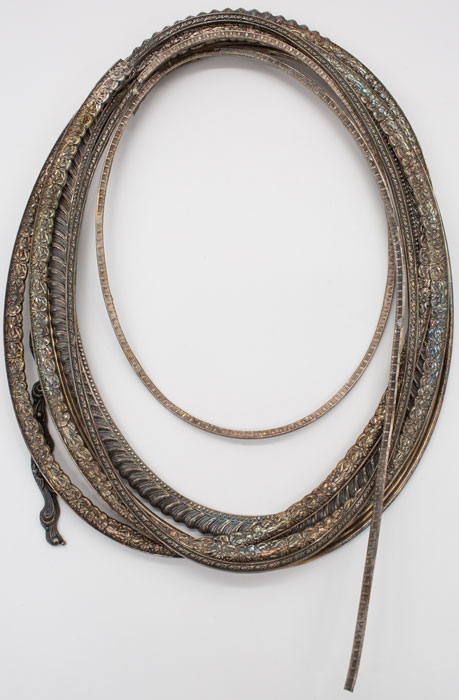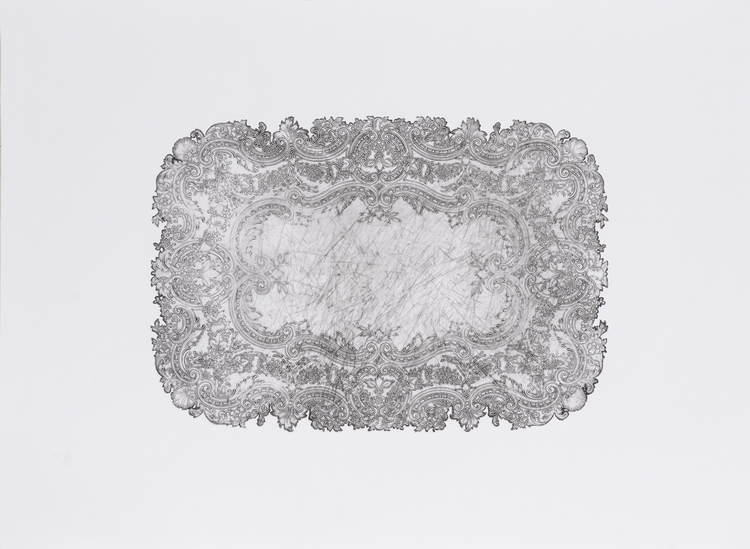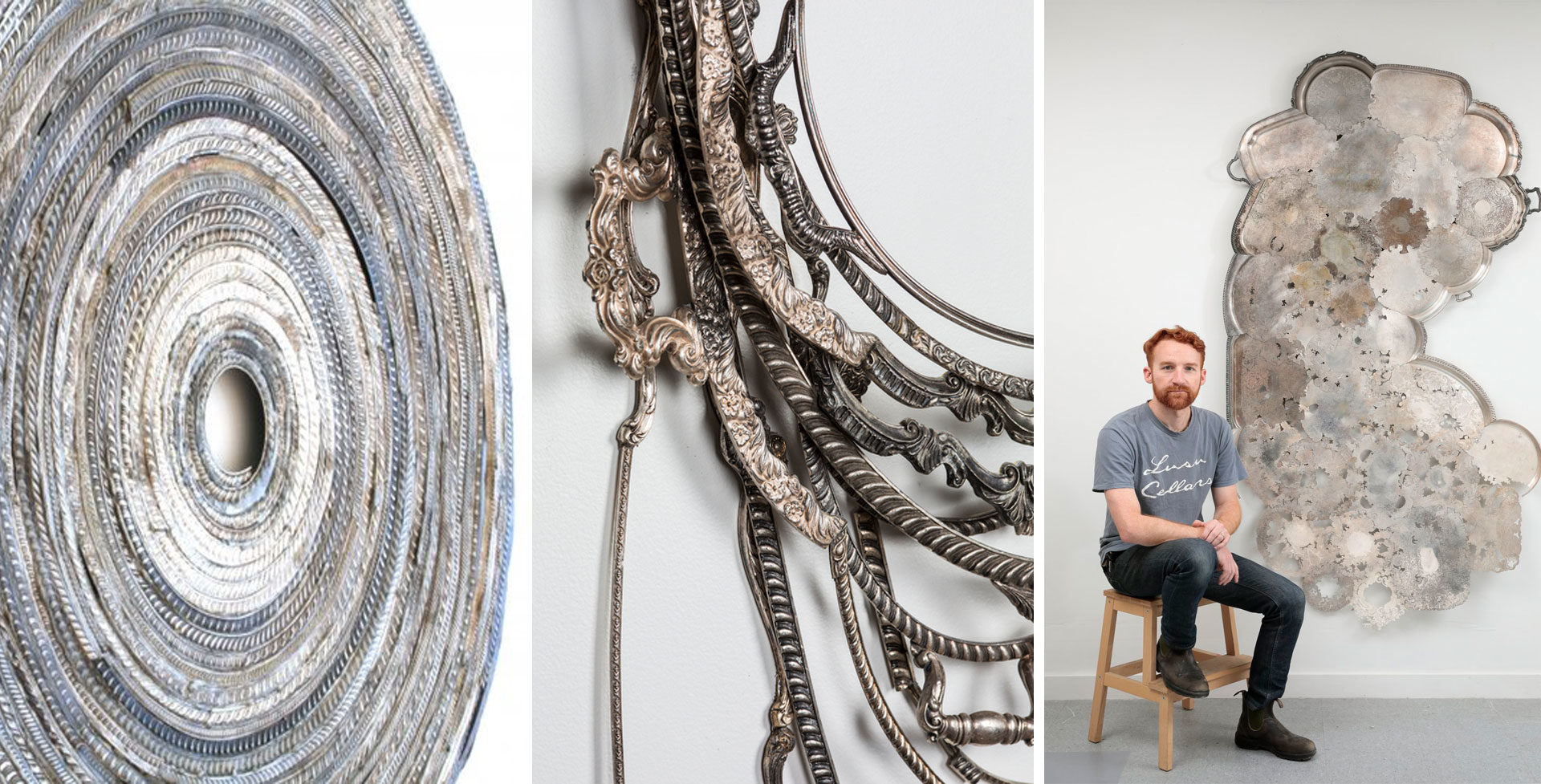Jaydan Moore was born into a family of fourth-generation tombstone makers in Northern California. Most of his childhood was spent at the family business, which doubled as a rental storage space. He would rummage through other people’s objects that were left behind, and listen to family members making burial arrangements for their loved ones. It is through these experiences he began to value the heirlooms and objects chosen to become markers for significant moments that occur during the human experience.
His career began as an undergraduate student at California College of the Arts, in Oakland and he received his MFA and MA from the University of Wisconsin-Madison. Jaydan’s work is in the permanent collection of the Carnegie Museum of Art (PA), Museum of Fine Arts-Houston (TX), and Honolulu Museum of Art (HI). He has furthered his career through generous opportunities as an artist in residence at Penland School of Crafts, Kohler Arts/Industry Program, the Fountainhead Fellowship at Virginia Commonwealth Universities Craft/Material Studies Program, and Houston Center for Contemporary Craft.

For a lot of kids, death isn’t a part of life that they often think about, if they’re lucky. How has that experience of it being part of your childhood influence you?
I think it influenced me tremendously. It’s so funny as artists how those childhood moments can have such a major impact. I was talking to my wife about it once and she pointed out it’s an understanding of the finiteness of life. I think it was really amazing to get to see how we all are living these communal lives. I think that created this understanding of how we’re similar and how the objects that we live with actually can show our similarities at the same time.
I think the other thing was, my family also had these storage facilities and that kind of duality was like, oh, it’s really interesting that we’re all also kind of material objects, right? We all start off similar, but then what we do in life affects who we are and makes us more individual.

As far as your process, I have to think there’s a relationship between you and the object. How does the object you start with and how the metal reacts influence the final product?
Usually, it’s two different directions. Either I’m trying to shoot for a size (usually for a commission) or I’m working on a new process. In that case, I’m building off that process, getting better and more efficient at it, but also seeing where it can lead and grow.
The platters themselves are their own little swatches of color and pattern. Because I use low-temp solder to solder everything, I can’t go back and clean because I want to keep the patina together. It really shows wherever I may make a mistake and I have to live with it. I like it because I can’t be a perfectionist and it shows that these objects that we all care for don’t come together so sweetly and perfectly. There’s going to be kind of misses and mashes, you know? Soldering is not one of my favorite things in the world, but the concept makes the most sense to me, and I feel like it gives weight to the whole object.

What are the challenges with soldering that way?
Most metalsmiths use high temp, which is 1,200 to 1,500 degrees Fahrenheit and it’s a really nice bond—almost like the silver solder is flooding and making a new alloy. Low-temp solder is 500 to 600 degrees Fahrenheit, so the bond is almost more like superglue.
The piece at Brush Creek and these bigger sculptures, all of them are silver plated, so it’s brass or copper with a very thin layer of silver. When I first started, high-temperature solder would sometimes flake the silver, which I really wanted to keep. I also found that if you use older platters from the forties and fifties, the plating is so good and so thick that it will hold up, which can be really cool.
In the past few years, as baby boomers have gotten older and there’s this surge of people going through their parents’ houses, what was once a valued possession in dinnerware has become more obsolete. Do you think about that evolution in your work?
I find it to be such a beautiful, interesting evolution. What you’re describing is totally true that most of these objects were given as retirement gifts or trophies or for weddings. They were used mostly when you had a lot of people coming over and our society has slowly shied away from that. We’ve gone toward more nicer functional objects for day to day that we use all the time.
I think both ideas are beautiful. I’m more curious about how things change and evolve. I think the first couple of platters that I made were to allude to some sort of functionality. As I’ve seen people not need these items functionally anymore, I’ve pushed the work to be more of a decorative object, almost like a tapestry.
The next iteration is what I’m working on where it’s purely material now. It’s really just recycled goods, which I think is valuable as well. When I first started, I thought there might be a time when I have to end this body of work because I’ll have used up all of the platters on eBay and it’s not happening. I’m barely scratching the surface. I have not bought a brand new piece of metal for 10 years. There’s something ecologically conscious about the material that is just living out there instead of mining more.

Where did the idea for creating prints come from and how has that added a different dimension to your work?
I think that idea has always been in my brain. I always say to do that weird 10-minute idea that you have in your head because it can turn into a huge new venture. My graduate work was with a printmaker and I’d done some printmaking, so I asked her if I could give it a shot. We printed a couple plates and it just kept growing and it’s turned into a part of the business. I make a print for anyone who donates a platter to me as a thank you. It’s a nice way to tell what we were talking about earlier, that these objects do have significance. Oddly enough, the prints really brought everything full circle, because my job as a kid was to go out and do rubbings of the tombstones.

What’s next for you?
I have a pretty slow gallery show calendar, so I’m really working on some new work, which is in that fourth dimension. I’m trying to work very, very hard on getting a whole new body of work done in the next six months. I have a big commission for a museum in Australia that’s for 2023 that I am collecting for feverously. My studio is hundreds of platters sitting around, waiting for this piece to get off the ground!
